Key takeaways:
- Automation enhances productivity by transforming mundane tasks into efficient processes, allowing for greater focus on creative and impactful work.
- Identifying repetitive, time-consuming, and error-prone tasks is crucial for effective automation implementation.
- Choosing the right automation tools requires understanding specific needs and prioritizing user-friendliness to minimize complexity.
- Regularly adjusting and optimizing automation processes, along with gathering feedback, can lead to substantial improvements and personalized experiences.

Understanding automation for productivity
When I first delved into automation, I was struck by how it transformed mundane tasks into streamlined processes. I remember feeling overwhelmed by the constant stream of emails I received daily, but implementing an automated response system not only alleviated my stress but also allowed me to focus on more critical tasks. Have you ever felt similarly burdened by routine responsibilities?
Automation isn’t just about replacing tasks; it’s about enhancing creativity and productivity. For instance, after utilizing automation tools for scheduling, I could reclaim hours in my week. This newfound time ignited my creativity, allowing me to brainstorm and innovate in ways I hadn’t imagined before. Isn’t it empowering to turn tedious time-wasters into moments of inspiration?
As I look back, the emotional lift I experienced from embracing automation was profound. The weight of endless to-do lists slowly lifted, and I felt a renewed sense of control over my work. Doesn’t the thought of regaining that sense of agency sound appealing? By understanding and integrating automation into my daily routine, I found not just productivity but a more enriching work experience overall.
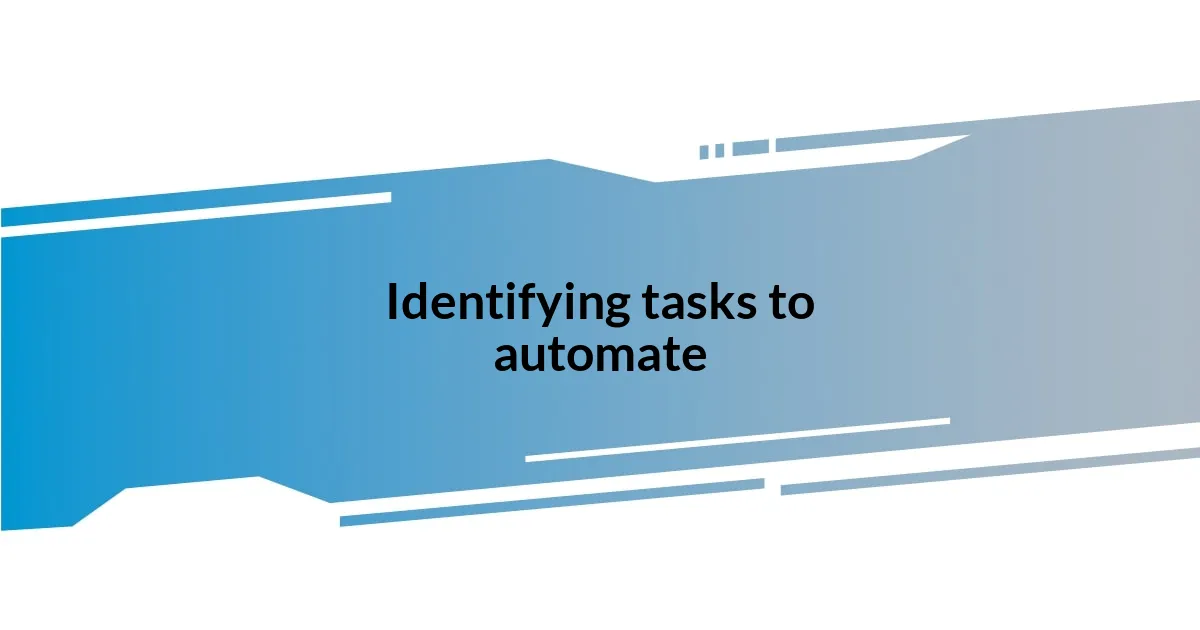
Identifying tasks to automate
Identifying tasks to automate was one of the most eye-opening experiences I had. Initially, I just jotted down my daily routines without much thought. But as I scrutinized my list, I realized how many tasks were eating away at my time, often repeating themselves day after day. Take email filtering, for example. By setting up automatic rules to sort my incoming messages, I not only saved time but alleviated the frustration of missing important communications.
Here’s how I pinpointed the ideal tasks for automation:
- Repetitive Tasks: I listed tasks I performed daily or weekly, such as data entry or report generation.
- Time-Consuming Activities: I noted tasks that consumed a significant portion of my day, like managing social media posts or scheduling meetings.
- Error-Prone Processes: I identified areas where I often made mistakes, such as manual calculations, which could easily be automated for greater accuracy.
- High-Energy Tasks: I recognized activities I dreaded, like compiling invoices, realizing that automation could help me tackle them with less mental strain.
Focusing on these areas made the process of adopting automation much more effective. I discovered that when I combined simple technology with thoughtful analysis, I could reshape my daily workflow and lighten my emotional load. The relief of watching those time-sucking tasks shrink was nothing short of a revelation.
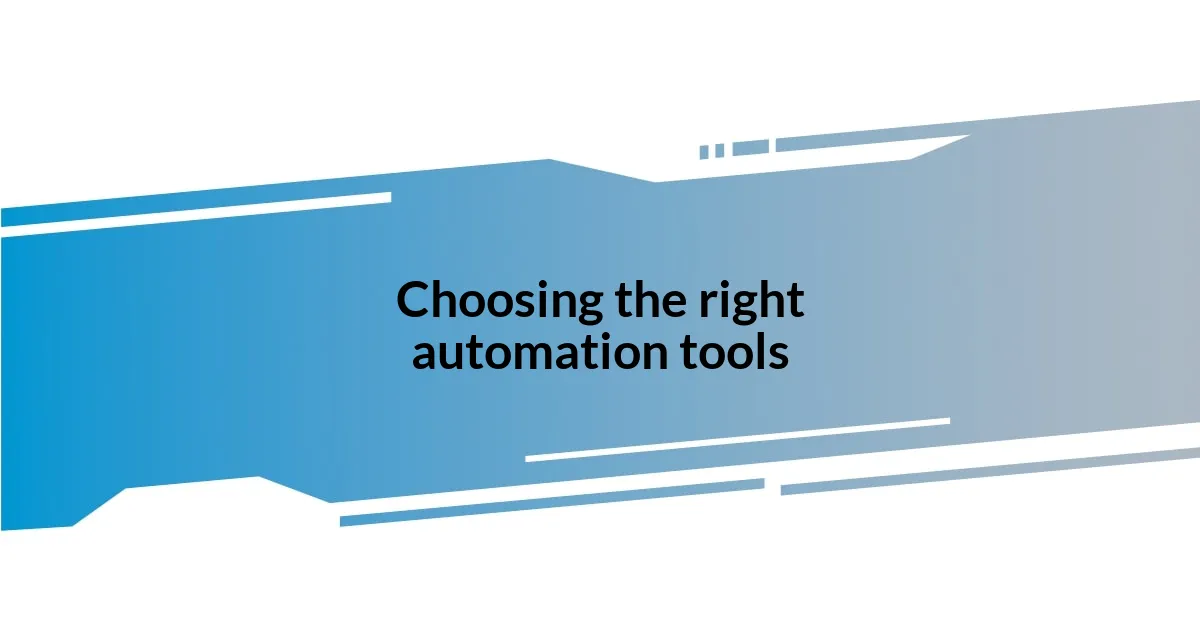
Choosing the right automation tools
When it comes to selecting the right automation tools, I’ve found that understanding specific needs is crucial. At first, I jumped into using a popular tool that everyone raved about, only to realize it didn’t quite suit my workflow. It felt like trying to fit a square peg into a round hole. Now, I take the time to assess my tasks carefully, weighing the features and compatibility of each tool against what I truly need. Have you ever felt the frustration of using a tool that just doesn’t align with your processes?
Additionally, it’s important to consider user-friendliness. In my early days of automation, I often overlooked this aspect. I remember getting tangled in complex setups that sapped my energy rather than saved it. I now prioritize tools that offer a simple interface and clear tutorials. This way, I can dive right in and start automating without a steep learning curve. Have you considered how much time you could save by avoiding convoluted systems?
Finally, I suggest testing automation tools before committing fully. For instance, I trialed different software options for project management and was pleasantly surprised to find one that not only fit my style but enhanced my team’s collaboration. This experience underscored the value of a hands-on approach to choosing tools, allowing flexibility and fostering productivity. You might discover that what looks good on paper doesn’t always work seamlessly in practice.
| Tool | User-Friendliness |
|---|---|
| Zapier | Easy, with numerous integrations |
| Asana | Intuitive layout, quick to set up |
| IFTTT | Simple for beginners; creative automation |
| Microsoft Power Automate | Steeper learning curve; powerful for complex tasks |
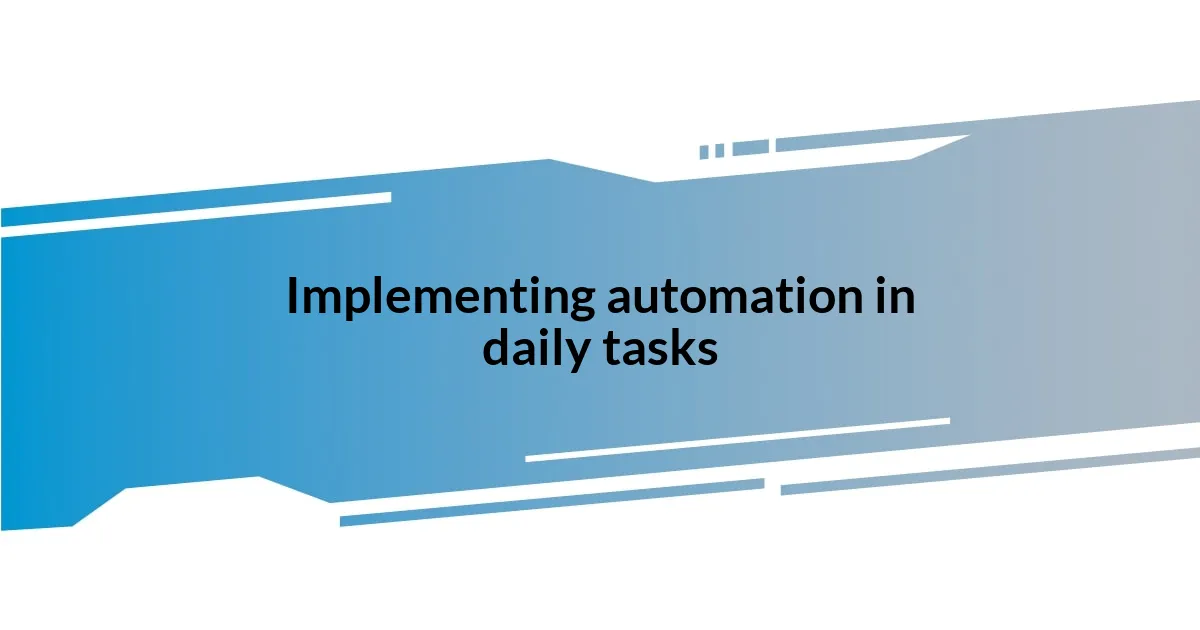
Implementing automation in daily tasks
Implementing automation in my daily tasks has truly transformed my workflow in ways I never expected. One of the first steps I took was utilizing scheduling software for my social media posts. On days when my to-do list felt overwhelming, knowing that my content was being published automatically gave me peace of mind and allowed me to focus on other vital priorities. Have you ever experienced that sudden rush of relief when technology simply handles a task for you?
Another impactful change was the adoption of automated reminders for meetings and follow-ups. I remember missing an important call once because my calendar was buried under a pile of other commitments. Now, by setting reminders that ping my phone and email, I never overlook crucial interactions. This small adjustment freed my mental space and significantly reduced my anxiety around scheduling. Doesn’t it feel great when technology acts as a trustworthy ally rather than an additional burden?
I also integrated automation for mundane tasks like invoice generation. Initially, I dreaded sitting down to compile every detail, only to worry about math errors or missed entries. Switching to an invoicing software that generates and sends invoices automatically changed my perception completely. I felt a wave of liberation; additionally, I could focus on client relationships rather than paperwork. This transformation not only improved my productivity but genuinely brightened my workday. Isn’t it fascinating how automating simple tasks can drastically improve our experiences and mental well-being?
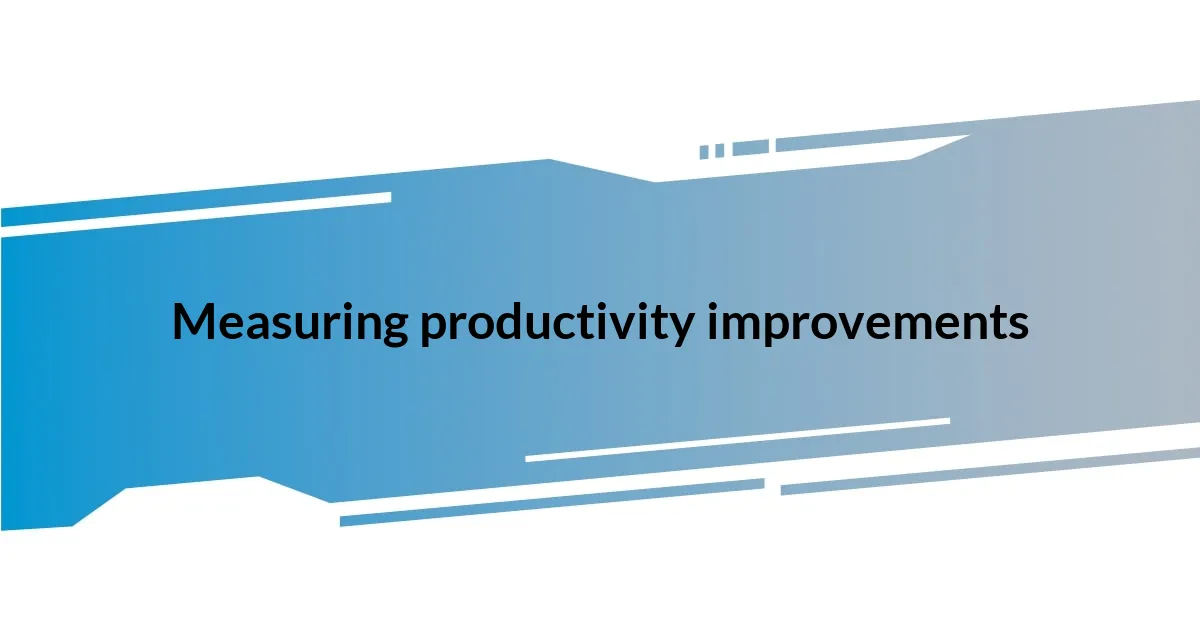
Measuring productivity improvements
Measuring productivity improvements can initially seem daunting, but I’ve found a few straightforward methods that truly illuminate progress. One practical approach is tracking the time spent on specific tasks before and after implementing automation. For instance, when I automated my email responses, I noticed a significant reduction in the time spent on communication. Have you ever calculated how much time seemingly small tasks consume in your day? Seeing the numbers often opens my eyes to the impact of automation.
Another effective measure is assessing output quality and consistency. I recall a time when my reports took ages, often feeling rushed and unrefined. After integrating automation into my data collection, not only did I complete my reports much faster, but they also became more polished and insightful. It’s like looking in a mirror and seeing a clearer reflection of your efforts. Have you experienced a similar shift in quality after making a process smoother?
Lastly, I recommend using specific metrics tailored to your profession. For instance, if you’re in sales, monitoring the number of leads followed up with could reveal how automation enhances your reach. In my case, by automating follow-ups, I transformed my lead engagement from sporadic to systematic. It felt empowering to see those numbers grow, almost like watching a garden bloom. What metrics resonate with you, and how could they measure your progress in real-time?
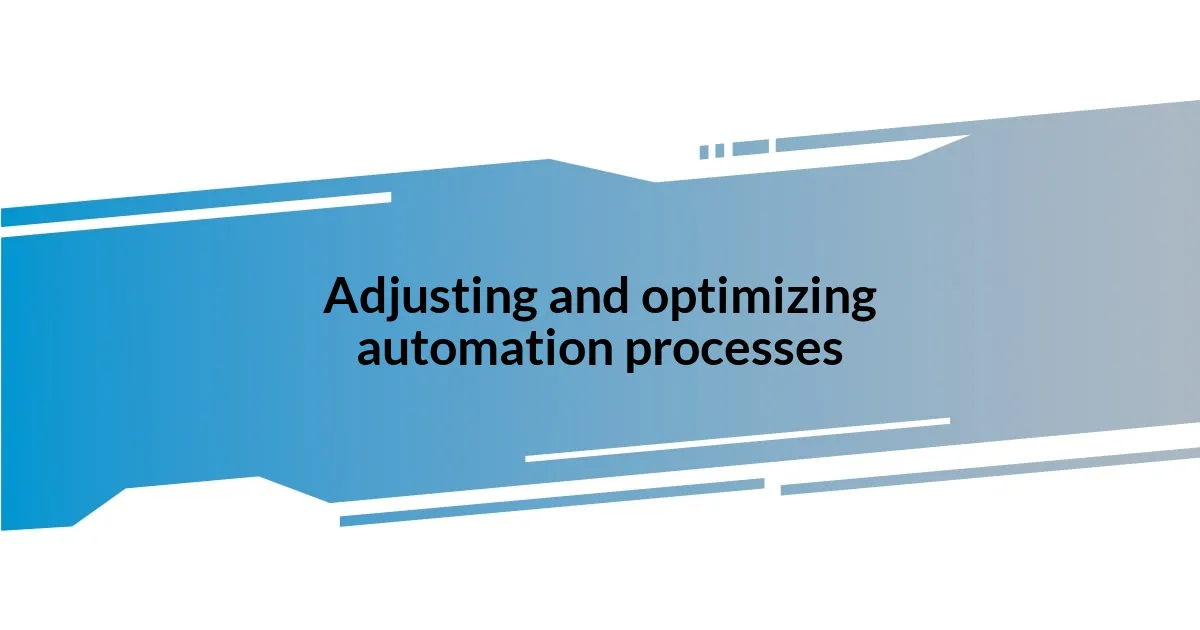
Adjusting and optimizing automation processes
Adjusting automation processes is an ongoing journey. Sometimes, I find myself reassessing how a tool fits into my workflow. For instance, I initially set up a notification for every email I received, but it quickly became overwhelming. By simplifying it to critical messages only, I regained focus without feeling bombarded. Have you ever had to cut back on notifications to reclaim your mental clarity?
I also learned the importance of regular reviews. Initially, I’d implement an automation and forget about it, assuming all was well. However, I discovered that revisiting these processes can expose inefficiencies. For example, after a few weeks of using automated social media scheduling, I realized I needed to adjust the timing of my posts to match my audience’s engagement trends better. It was eye-opening to see how minor tweaks could yield significantly better results. Have you checked in on your own automated systems lately?
Another key aspect of optimization is gathering feedback. When I automated customer feedback forms, I thought the data would speak for itself. However, engaging directly with my customers revealed insights I hadn’t anticipated. They shared preferences that guided me to refine the automated responses for a more personalized touch. Have you considered how direct communication can help shape your automated processes?
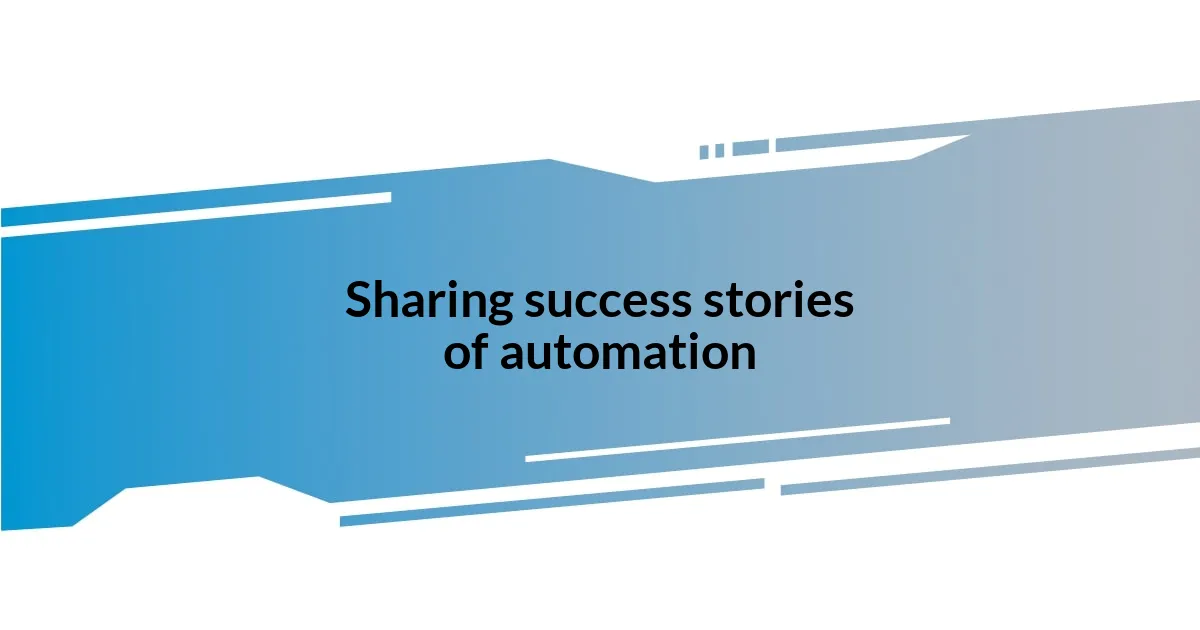
Sharing success stories of automation
One of the most inspiring success stories of automation comes from a friend who runs a small online business. After she implemented an inventory automation system, her once chaotic stock management transformed into a seamless operation. I remember her excitement when she shared that, for the first time, she could accurately track inventory levels and prevent stockouts, which boosted her sales and customer satisfaction tremendously. Doesn’t it feel validating when technology helps you stay ahead of demand?
In my own experience, I once automated my project management tasks using a simple tool that aligned with my workflow. The results were astounding. I found that not only was I able to keep track of deadlines more efficiently, but I also reduced the stress that came with juggling multiple tasks. For example, reminders I had to manually send now triggered automatically, and I felt a weight lift off my shoulders. Have you ever experienced the relief of knowing your to-do list just got a whole lot lighter thanks to automation?
Success stories are not just numbers or software; they are deeply personal experiences. I vividly recall a moment when I automated my scheduling process, which was previously a source of frustration. I would spend hours coordinating meetings, but with automation in place, I created a system that handled this effortlessly. The time saved allowed me to focus on creative work that ignited my passion. Have you ever realized that automation can free up space in your life for what truly matters?